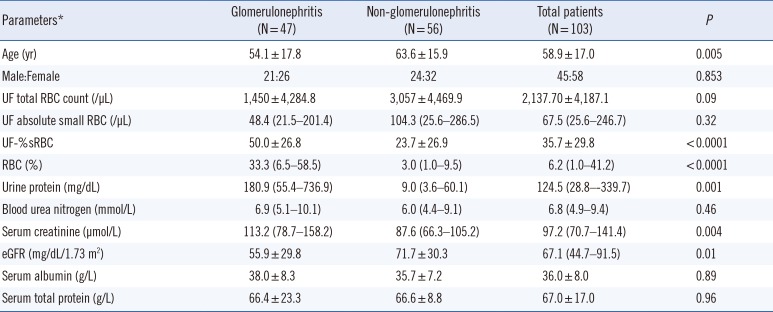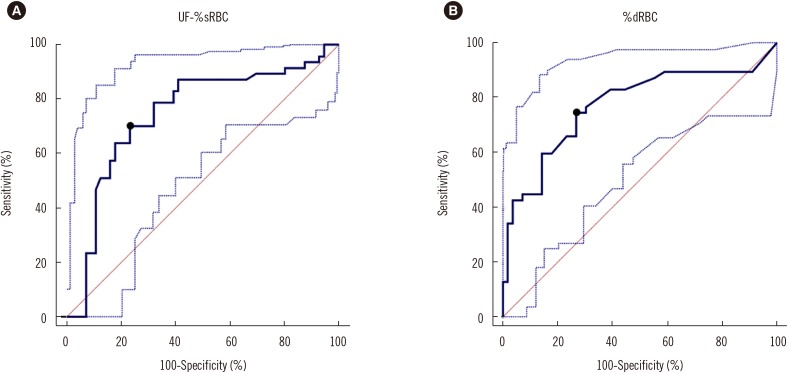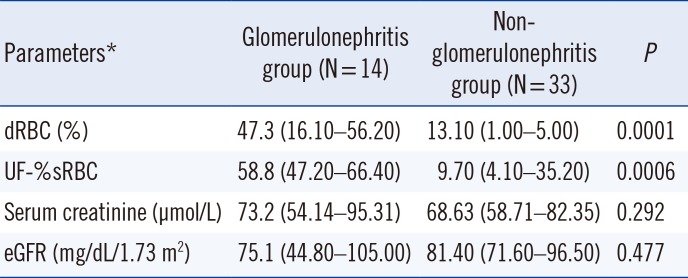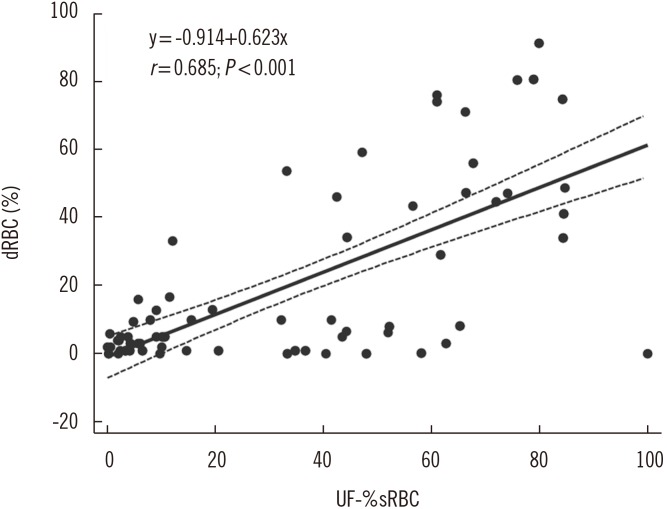1. Chae DW. Current status of primary glomerulonephritis. Korean J Med. 2013; 84:1–5.
2. Fairley KF, Birch DF. Hematuria: a simple method for identifying glomerular bleeding. Kidney Int. 1982; 21:105–108. PMID:
7077941.
3. De Santo NG, Nuzzi F, Capodicasa G, Lama G, Caputo G, Rosati P, et al. Phase contrast microscopy of the urine sediment for the diagnosis of glomerular and nonglomerular bleeding-data in children and adults with normal creatinine clearance. Nephron. 1987; 45:35–39. PMID:
3543709.
4. Shichiri M, Hosoda K, Nishio Y, Ogura M, Suenaga M, Saito H, et al. Red-cell-volume distribution curves in diagnosis of glomerular and non-glomerular haematuria. Lancet. 1988; 1:908–911. PMID:
2895832.
5. Shichiri M, Oowada A, Nishio Y, Tomita K, Shiigai T. Use of autoanalyser to examine urinary-red-cell morphology in the diagnosis of glomerular haematuria. Lancet. 1986; 2:781–782. PMID:
2876237.
6. Racki S, Grzetić M, Prodan-Merlak Z, Vuksanović-Mikulicić S, Sladoje-Martinović B, Zivcić-Cosić S. Clinical use of phase-contrast microscopy in the differential diagnosis of microhematuria. Acta Med Croatica. 2003; 57:11–16. PMID:
12876856.
7. Ito CA, Pecoits-Filho R, Bail L, Wosiack MA, Afinovicz D, Hauser AB. Comparative analysis of two methodologies for the identification of urinary red blood cell casts. J Bras Nefrol. 2011; 33:402–407. PMID:
22189802.
8. Chu-Su Y, Shukuya K, Yokoyama T, Lin WC, Chiang CK, Lin CW. Enhancing the detection of dysmorphic red blood cells and renal tubular epithelial cells with a modified urinalysis protocol. Sci Rep. 2017; 7:40521. PMID:
28074941.
9. Fogazzi GB, Grignani S. Urine microscopic analysis–an art abandoned by nephrologists? Nephrol Dial Transplant. 1998; 13:2485–2487. PMID:
9794548.
10. Davis R, Jones JS, Barocas DA, Castle EP, Lang EK, Leveillee RJ, et al. Diagnosis, evaluation and follow-up of asymptomatic microhematuria (AMH) in adults: AUA guideline. J Urol. 2012; 188:2473–2481. PMID:
23098784.
11. Uno D, Kawakami S. UF-1000i/UF-500i clinical case study. 2nd ed. Kobe: Sysmex Corporation;2014. p. 1–35.
12. Jiang T, Chen P, Ouyang J, Zhang S, Cai D. Urine particles analysis: performance evaluation of Sysmex UF-1000i and comparison among urine flow cytometer, dipstick, and visual microscopic examination. Scand J Clin Lab Invest. 2011; 71:30–37. PMID:
21091139.
13. Hyodo T, Kumano K, Sakai T. Differential diagnosis between glomerular and nonglomerular hematuria by automated urinary flow cytometer. Kitasato University Kidney Center criteria. Kitasato University Kidney Center criteria. Nephron. 1999; 82:312–323. PMID:
10450033.
14. Nguyen GK. Urine cytology in renal glomerular disease and value of G1 cell in the diagnosis of glomerular bleeding. Diagn Cytopathol. 2003; 29:67–73. PMID:
12889042.
15. van der Zwet WC, Hessels J, Canbolat F, Deckers MM. Evaluation of the Sysmex UF-1000i® urine flow cytometer in the diagnostic work-up of suspected urinary tract infection in a Dutch general hospital. Clin Chem Lab Med. 2010; 48:1765–1771. PMID:
20726812.
16. Oyaert M, Delanghe J. Progress in Automated Urinalysis. Ann Lab Med. 2019; 39:15–22. PMID:
30215225.
17. CLSI. Urinalysis; approved guideline. CLSI GP16-A3. 3rd ed. Wayne, PA: Clinical and Laboratory Standards Institute;2009.
18. Broeren MA, Bahçeci S, Vader HL, Arents NL. Screening for urinary tract infection with the Sysmex UF-1000i urine flow cytometer. J Clin Microbiol. 2011; 49:1025–1029. PMID:
21248088.
19. Köhler H, Wandel E, Brunck B. Acanthocyturia–a characteristic marker for glomerular bleeding. Kidney Int. 1991; 40:115–120. PMID:
1921146.
20. Levey AS, Stevens LA, Schmid CH, Zhang YL, Castro AF 3rd, Feldman HI, et al. A new equation to estimate glomerular filtration rate. Ann Intern Med. 2009; 150:604–612. PMID:
19414839.
21. Pollock C, Liu PL, Györy AZ, Grigg R, Gallery ED, Caterson R, et al. Dysmorphism of urinary red blood cells–value in diagnosis. Kidney Int. 1989; 36:1045–1049. PMID:
2689749.
22. Fuiano G, Mazza G, Comi N, Caglioti A, De Nicola L, Iodice C, et al. Current indications for renal biopsy: a questionnaire-based survey. Am J Kidney Dis. 2000; 35:448–457. PMID:
10692270.
23. Sultana T, Sultana T, Rahman MQ, Ahmed ANN. Evaluation of haematuria and use of phase contrast microscope: a short review. J Dhaka Med Coll. 2011; 20:63–67.
24. Santangelo L, Netti GS, Giordano P, Carbone V, Martino M, Torres DD, et al. Indications and results of renal biopsy in children: a 36-year experience. World J Pediatr. 2018; 14:127–133. PMID:
29569185.
25. Jo YI. Diagnosis of primary glomerular diseases. Korean J Med. 2013; 84:6–12.
26. Albani JM, Ciaschini MW, Streem SB, Herts BR, Angermeier KW. The role of computerized tomographic urography in the initial evaluation of hematuria. J Urol. 2007; 177:644–648. PMID:
17222650.
27. Crop MJ, de Rijke YB, Verhagen PC, Cransberg K, Zietse R. Diagnostic value of urinary dysmorphic erythrocytes in clinical practice. Nephron Clin Pract. 2010; 115:c203–c212. PMID:
20413998.
28. Stapleton FB. Morphology of urinary red blood cells: a simple guide in localizing the site of hematuria. Pediatr Clin North Am. 1987; 34:561–569. PMID:
3295717.









 PDF
PDF ePub
ePub Citation
Citation Print
Print




 XML Download
XML Download